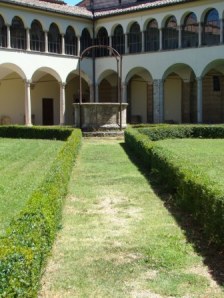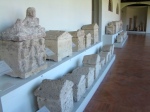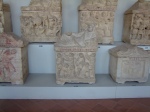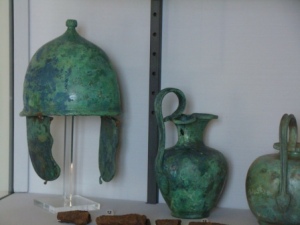Anthropology, archaeology…Whatever. This one’s for you, seestor.
Archeology
Sunday: Perugia Archeology Museum
On Sunday we visited the Museo Archeologico Nazionale dell’Umbria. The museum is located in the southern end of the city in a beautiful old building that once housed the convent of San Domenico.
Upon passing through the main arch into the museum visitors are greeted by a large courtyard with a now unused well in the center.
View of the courtyard from the second story
Cinerary urns dating back to the 3rd-1st century B.C. line the four walls of the old cloister.
The museum is split into two major sections: prehistoric and Etruscan-Roman history. The Hubby posed next to this poster introducing the history of man exhibit. Yup…there’s that 96%.
Our stop at the next exhibit was one of the times during our visit that I really regretted not being able to understand Italian. This is an interactive display discussing evolution, creation and intelligent design. The gentleman on the left (my left) is a professor at one of the Italian universities, and the gentleman on the right is a clergyman. If no one is using the exhibit, both videos are on a loop to show the men sitting calmly, twiddling their thumbs (literally in some instances), waiting to answer your questions.
Here is a close up of the computer display. For each question you can get the viewpoint of both the scientist and the clergyman. There are questions about evolution, creation science and intelligent design. I’d love to hear the respones from the two speakers…and to know if the exhibit is biased one way or the other.
Further on in the museum we found a really neat room that contained two sarcophagi (-gus? -gueses?).
This sarcophagus that the Hubby is crouched in front of is described in one of the English-language guidebooks. It’s not only neat because it’s a box that held an important dead dude; it contains historical information of the city. From the guidebook:
This is the first major document of the city’s history and was made in Chiusi at the end of the 6th century B.C. On the front is a frieze showing the return from a victorious military expedition with a procession of soldiers carrying valuable booty: prisoners, objects loaded onto beasts of burden and herds of livestock. Two banqueting scenes ornament the sides of the chest.
The second sarcophogus contains the remains of it’s original inhabitant:
The Hubby gets up close and personal with a human ancestor.
In my touristy, non-Italian-speaking, non-professional opinion, the exhibit halls were very well set up. The displays were spread out and labelled and described in detail, the walls and spaces in each room were well-used and everything flowed in a linear fashion, i.e., we didn’t have to retrace our steps while moving from room to room.
One hallway in the museum -each doorway on the left leads to a small exhibit room.
Cool pyramid display cases – part of the museum’s amulet collection.
Copper helmet, pitchers
Slingshot projectiles display
One of the exhibits that really elicited a sense of awe from me was the Perugia cippus stone – an ancient (2nd-3rd century B.C.) boundary stone that used to be located at the edge of the city. The writing is Etruscan, and the museum has blown-up a copy of the writing and placed it on the exhibit wall. It highlights the different paragraphs on the stone, as well as names, places, and even mistakes made by the stonecutter. From the guidebook:
This travertine block was a boundary marker. The text records the agreements stipulated between the Velthina and Afuna families regarding the ownership or use of various pieces of land, on which stood, among other things, a tomb belonging to the Velthina.
Front of the cippus
Side of the cippus
An artist’s rendition of travelers or land dwellers standing around the cippus
That’s about it for the museum. We were getting hungry and ready to sit for a while, so we headed out to find a trattoria. But not before getting a few more pictures of the view from the museum.
More roof tiles…I love these things!
A final picture of the courtyard and the church of San Domenico rising up in the background.

























